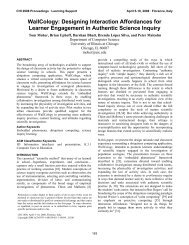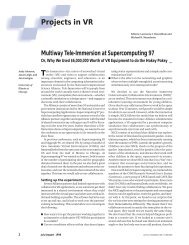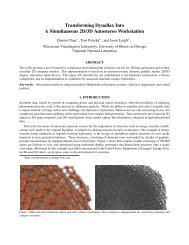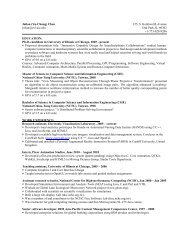The Future of the CAVE - Electronic Visualization Laboratory ...
The Future of the CAVE - Electronic Visualization Laboratory ...
The Future of the CAVE - Electronic Visualization Laboratory ...
You also want an ePaper? Increase the reach of your titles
YUMPU automatically turns print PDFs into web optimized ePapers that Google loves.
Figure 20. <strong>The</strong> KAUST REVE 18-panel display using <strong>the</strong> CGLX-based CineBlaster3D video<br />
playback module. Julia4D Animation: Dan Sandin. Photo: Tom DeFanti.<br />
From <strong>the</strong> above discussions, it is clear that VR encumbrances, like special glasses, would be best<br />
eliminated and that synchronization and polarization also inhibit ubiquity. Scalability is also<br />
desirable, as multi-tile displays are <strong>the</strong> only way to achieve resolutions exceeding 4096x2160<br />
pixels with technology in <strong>the</strong> near future. To explore scalable autostereo using commercially<br />
available displays, Calit2 designed an autostereo display called REVE (Rapidly Expandable<br />
Virtual Environment) [Figure 20] in 2009.<br />
REVE is a flat wall <strong>of</strong> multiple 3D autostereo LCD displays based on LPP technology. <strong>The</strong><br />
KAUST REVE has 18 42” panels in a 6x3 array, making a display 6.11m-by-1.83m in size;<br />
Calit2 has 9 24” panels in a 3x3 configuration. Several competing lenticular systems were<br />
evaluated, and <strong>the</strong>n Calit2 prototyped tiled configurations <strong>of</strong> three, six, and nine 24” Alioscopy<br />
displays [Alioscopy]. In addition, new display drivers were written, s<strong>of</strong>tware adapted, and<br />
techniques for synchronized playback <strong>of</strong> multi-screen, pre-computed, compressed animations<br />
were developed. This was effectively all new effort, building on <strong>the</strong> past 20 years <strong>of</strong> autostereo<br />
research.<br />
REVE’s s<strong>of</strong>tware is interactive, making it possible for viewers to control parameters directly in<br />
real-time scientific computations with precision and high resolution, at a speed <strong>of</strong> 30+ frames per<br />
second. Consumers need this capability for 3D games, among o<strong>the</strong>r uses. As with any spatially<br />
multiplexed display, and especially with LPP ones, resolution is a fraction <strong>of</strong> HDTV; however,<br />
resolution is regained in REVE by tiling <strong>the</strong> displays.<br />
A current shortcoming with <strong>the</strong> REVE display is its narrow z-depth, which limits its use to<br />
shallow 3D objects like friezes and etchings; typical VR fly-through images are not successful.<br />
Calit2/EVL developed a real-time depth compression technique that automatically compresses <strong>the</strong><br />
3D scene to <strong>the</strong> usable z-axis range, which works well with some types <strong>of</strong> images, but not with<br />
o<strong>the</strong>rs [Figures 21-22]. This issue is made worse by tiling, not better, unfortunately, since even as<br />
<strong>the</strong> image’s x and y dimensions increase, <strong>the</strong> useful depth does not, making <strong>the</strong> resulting images<br />
more comparatively compressed in z, and thus more flat-looking. Never<strong>the</strong>less, <strong>the</strong> images are<br />
more dimensional than 2D representations <strong>of</strong> <strong>the</strong> same data, if carefully designed for <strong>the</strong> z-axis<br />
constraints.







